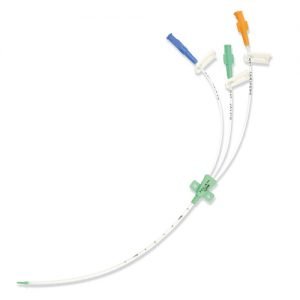
A central venous catheter (CVC), also known as a central line, central venous line, or central venous access catheter, is a catheter placed into a large vein. Catheters can be placed in veins in the neck (internal jugular vein), chest (subclavian vein or axillary vein), groin (femoral vein), or through veins in the arms (also known as a PICC line, or peripherally inserted central catheters). It is used to administer medication or fluids that are unable to be taken by mouth or would harm a smaller peripheral vein, obtain blood tests (specifically the “central venous oxygen saturation”), and measure central venous pressure.
Medical uses:
Reasons for the use of central lines include:
- Long-term intravenous antibiotics
- Long-term parenteral nutrition, especially in chronically ill persons
- Long-term pain medications
- Chemotherapy
- Drugs that are prone to cause phlebitis in peripheral veins (caustic), such as:
- Calcium chloride
- Chemotherapy
- Hypertonic saline
- Potassium chloride (KCl)
- Amiodarone
- Vasopressors (for example, epinephrine, dopamine)
- Plasmapheresis
- Peripheral blood stem cell collections
- Dialysis
- Frequent blood draws
Frequent or persistent requirement for intravenous access- Need for intravenous therapy when peripheral venous access is impossible
- Monitoring of the central venous pressure (CVP) in acutely ill people to quantify fluid balance
Central venous catheters usually remain in place for a longer period than other venous access devices, especially when the reason for their use is longstanding (such as total parenteral nutrition in a chronically ill person). For such indications, a Hickman line, a PICC line, or a Port-a-Cath may be considered because of their smaller infection risk. Sterile technique is highly important here, as a line may serve as an entry point for pathogenic organisms. Additionally, the line itself may become infected with bacteria such as Staphylococcus aureus and coagulase-negative Staphylococci
Complications
- Pneumothorax
- Bloodstream infections
- Thrombosis
- Misplacement
Types

Implanted port
A

PICC line
Non-tunneled & tunneled catheters


